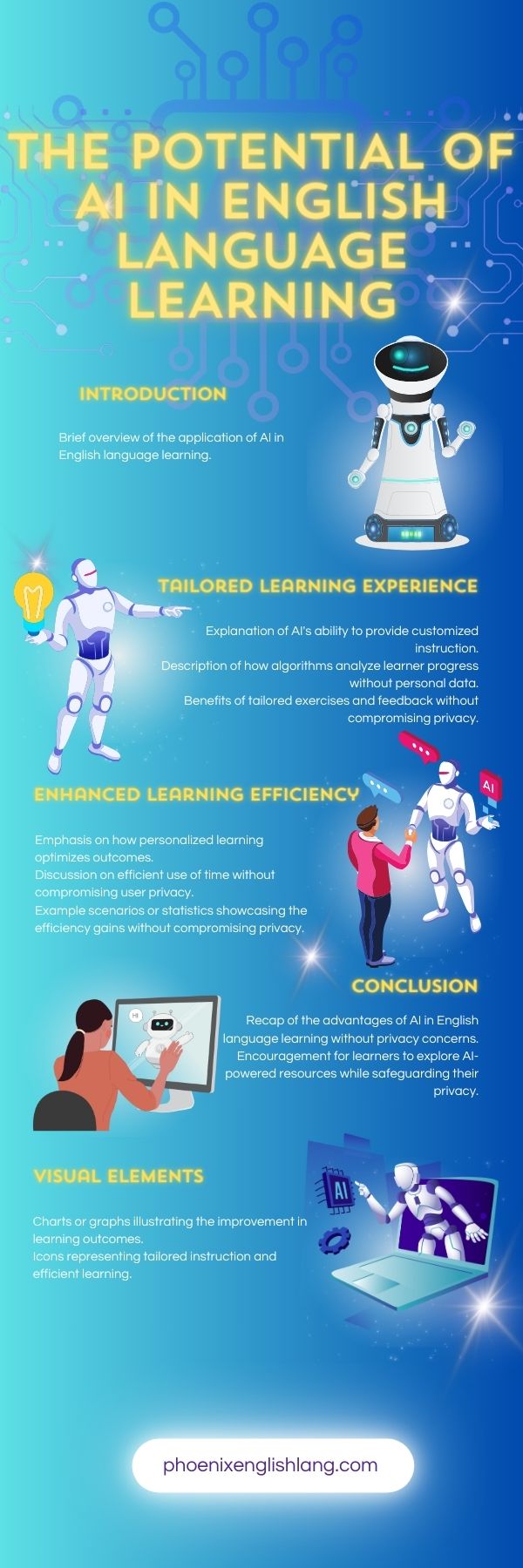Artificial Intelligence (AI) has emerged as a powerful tool in various fields, and its impact on English learning is no exception.
With its ability to analyse data, provide personalised instruction, and simulate human-like interactions, AI is revolutionising the way individuals acquire the English language.
This essay explores how AI is transforming English learning, its benefits, and potential implications for the future.
Personalised Instruction

One of the significant advantages of AI in English learning is its capacity to offer personalised instruction. AI algorithms analyse learners’ progress, identify strengths and weaknesses, and tailor learning materials accordingly.
Learners receive customised exercises and feedback, allowing them to focus on areas that require improvement. This personalised approach optimises learning outcomes and ensures that learners make efficient use of their time.
You might also enjoy: Thanks God or Thank God – Fully Explained + Video
Real-time Feedback and Assessment
AI-powered virtual tutors provide real-time feedback and assessment, enabling learners to gauge their progress instantly.
These virtual tutors can analyse pronunciation, grammar usage, vocabulary acquisition, and other language skills. Immediate feedback helps learners correct errors, refine their language abilities, and build confidence.
This continuous assessment fosters a deeper understanding of the language and accelerates language acquisition.
Natural Language Processing and Conversational Practice

AI employs Natural Language Processing (NLP) techniques to simulate human-like conversations, enhancing conversational practice for English learners.
AI-powered chatbots and virtual assistants engage in interactive dialogues, allowing learners to practice their speaking and listening skills.
These AI-driven conversations provide a safe and supportive environment for learners to hone their language fluency, pronunciation, and comprehension skills without the fear of judgment.
Enhanced Language Resources
AI algorithms can efficiently process large amounts of data, curating and presenting vast language resources to learners.
AI-driven language learning platforms offer a wide range of materials, including articles, videos, podcasts, and interactive exercises.
Learners can access authentic and up-to-date content tailored to their language proficiency level, interests, and learning goals.
This vast array of resources enhances vocabulary, grammar, and cultural understanding, making language learning more engaging and effective.
Natural Language Generation

AI’s Natural Language Generation (NLG) capabilities enable the creation of interactive and engaging language learning content.
AI-powered tools can generate dialogues, stories, and scenarios that learners can interact with, allowing them to practice their language skills in context.
This interactive content fosters creativity, critical thinking, and problem-solving abilities, making the learning process more enjoyable and immersive.
Potential Implications and Challenges
While AI has immense potential in English learning, some challenges and considerations must be addressed.
Firstly, the ethical use of AI in language learning should prioritise data privacy and security. Learners’ personal information and data should be handled responsibly and transparently. Secondly, AI should not replace human interaction entirely.
Is this the end of English classrooms?
While AI has the potential to significantly enhance English language learning, it is unlikely to completely replace traditional English classrooms. Here are a few reasons why:
1. Human Interaction and Communication Skills
English classrooms provide learners with the opportunity to interact and communicate with real people, including teachers and fellow students. This face-to-face interaction fosters interpersonal skills, such as active listening, turn-taking, and non-verbal communication, which are crucial for effective language acquisition. AI, while capable of simulating conversations, cannot replicate the complexities and nuances of real-life interactions.
2. Contextual and Cultural Understanding
English classrooms often incorporate cultural and contextual aspects of language learning. Teachers can provide insights into cultural practices, idiomatic expressions, and social norms that are difficult to capture through AI alone. Classroom discussions and activities allow learners to explore and understand different perspectives, fostering a deeper appreciation for the English language and its cultural nuances.
3. Social and Collaborative Learning
English classrooms provide a social setting where learners can collaborate, practice language skills, and learn from each other. Group discussions, pair work, and team projects promote teamwork, problem-solving skills, and peer feedback. These collaborative activities cannot be fully replicated in an AI-driven environment, limiting opportunities for social learning and building interpersonal relationships.
4. Adaptability to Individual Needs
English classrooms offer flexibility in adapting to the diverse needs of learners. Teachers can provide individualised attention, address specific learning difficulties, and adjust instruction based on learners’ progress and preferences. While AI can provide personalised instruction to some extent, it may lack the intuition, empathy, and adaptability that human teachers possess.
5. Extracurricular Activities and Cultural Immersion
English classrooms often offer extracurricular activities, such as language clubs, cultural events, and field trips, which provide learners with opportunities to practice English in real-life situations and immerse themselves in the language and culture. These experiences go beyond language learning and contribute to holistic development, personal growth, and a deeper understanding of the English language.
You might also enjoy: Cream Rises to the Top [Definition + Examples]
Benefits of AI technology in English Learning

AI technology offers numerous potential benefits in the realm of English learning. First and foremost, it provides learners with personalised and adaptive learning experiences.
Through the analysis of individual strengths and weaknesses, AI can tailor content and exercises to match the learner’s specific needs, ensuring optimal progress and engagement.
AI-powered language learning platforms can offer instant feedback on pronunciation, grammar, and vocabulary usage.
This immediate feedback allows learners to rectify mistakes promptly, reinforcing correct language patterns and enhancing their overall language proficiency.
AI technology also enables the creation of interactive and immersive learning environments.
Virtual reality and augmented reality applications, coupled with AI, can simulate real-life scenarios, providing learners with practical opportunities to practice English in a variety of contexts.
This immersive experience enhances language acquisition by promoting active engagement and deepening comprehension.
Another significant benefit of AI in English learning is the access it provides to vast repositories of language resources.
AI algorithms can curate and recommend a wide range of authentic materials, including articles, videos, and podcasts, tailored to learners’ interests and proficiency levels.
This exposure to authentic language use fosters cultural understanding, expands vocabulary, and promotes independent learning.
This technology facilitates asynchronous learning, allowing students to study at their own pace and on their own schedule.
With AI-powered chatbots and language tutors, learners can access support and guidance at any time, overcoming barriers of time zones or limited availability of human instructors.
This flexibility empowers students with greater control over their learning journey and promotes self-directed learning.
AI technology fosters collaboration and community building among English learners.
Virtual classrooms and online language exchange platforms leverage AI to connect learners from around the world, enabling them to practice their English skills, exchange cultural experiences, and build international friendships.
This global network promotes language immersion and provides a supportive and motivating environment for English learners.
How does AI technology create a safe and supportive environment for English learners?

- AI technology plays a crucial role in creating a safe and supportive environment for English learners. Firstly, AI-powered platforms can provide learners with a non-judgmental and confidential space to practice their language skills. Learners may feel more comfortable making mistakes and taking risks without the fear of being negatively evaluated by their peers or instructors. This fosters a supportive atmosphere where learners can freely experiment and improve their English proficiency.
- AI algorithms can offer personalised feedback and guidance tailored to each learner’s needs. This individualised approach helps learners build confidence as they receive constructive criticism and specific suggestions for improvement. Unlike human instructors who may be limited by time constraints, AI technology can provide learners with continuous support, ensuring they have access to resources and assistance whenever they need it.
- AI-powered platforms can also incorporate features that promote inclusivity and accommodate different learning styles. For instance, learners with diverse abilities or learning preferences can benefit from adaptive interfaces that adjust the difficulty level or format of exercises based on their performance. This inclusivity ensures that learners of varying capabilities can engage with the material and progress at their own pace.
- AI can contribute to the creation of culturally sensitive content and learning materials. By analysing vast amounts of data and considering various cultural perspectives, AI algorithms can help identify and mitigate potential biases or stereotypes in language learning materials. This ensures that learners are exposed to content that is respectful, inclusive, and representative of different cultures and backgrounds.
- AI-powered chatbots and language tutors can provide emotional support to English learners. These virtual assistants can engage in empathetic conversations, offer encouragement, and address learners’ concerns or anxieties. This emotional support can be particularly valuable for learners who may feel self-conscious or anxious about their language abilities, creating a safe and reassuring environment.
- AI technology can facilitate collaboration and community building among English learners. Virtual classrooms and online language exchange platforms leverage AI to connect learners, allowing them to interact and learn from one another. This collaborative environment provides a sense of camaraderie, mutual support, and motivation, fostering a positive and empowering learning community.
- AI technology creates a safe and supportive environment for English learners through features such as non-judgmental feedback, personalised guidance, inclusivity, cultural sensitivity, emotional support, and collaborative opportunities. By leveraging AI, learners can feel more confident, empowered, and motivated in their English learning journey, ultimately leading to enhanced language acquisition and proficiency.
You might also enjoy: Trainer or Trainor: 10 Main Differences + Examples [2024]
Conclusion
AI technology offers a myriad of potential benefits in English learning. From personalised and adaptive learning experiences to instant feedback, immersive environments, access to vast language resources, flexible learning options, and global collaboration, AI empowers learners to develop their language skills more effectively and efficiently.
As AI continues to advance, its integration into English learning holds great promise for learners worldwide.
While AI has the potential to revolutionise English language learning, it is unlikely to replace traditional English classrooms entirely.
The human element, including face-to-face interaction, cultural understanding, social learning, and adaptability to individual needs, remains essential in language acquisition.
However, AI can complement traditional classrooms by providing personalised instruction, enhancing language resources, and offering additional practice opportunities.
The integration of AI into English classrooms can create a more dynamic and effective learning environment, combining the best of human and technological capabilities.

Hi, welcome to my blog! My name is Omid and I am thrilled to have you here! I am an English language teacher with 12 years of experience and hold multiple international certifications (TESOL, IELTS, TOEFL, PTE, CELTA). Additionally, I hold a PhD in Applied Linguistics with a specialization in Teaching English as a Second Language (TESL), which fuels my passion for teaching English and assisting others in mastering the language. To me, nothing is more rewarding than helping individuals enhance their English language abilities through various methods. So, let’s embark on this journey of learning English together.




